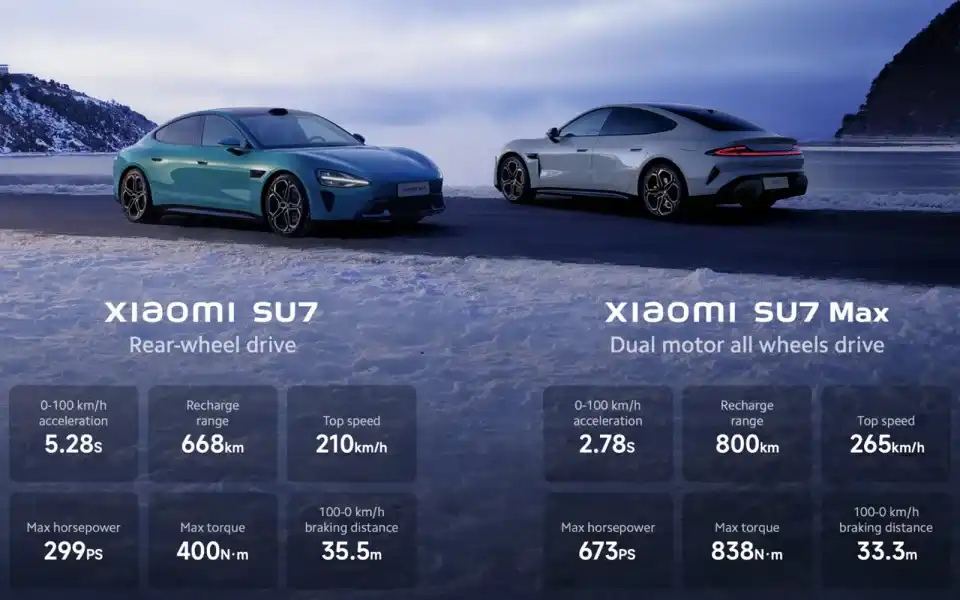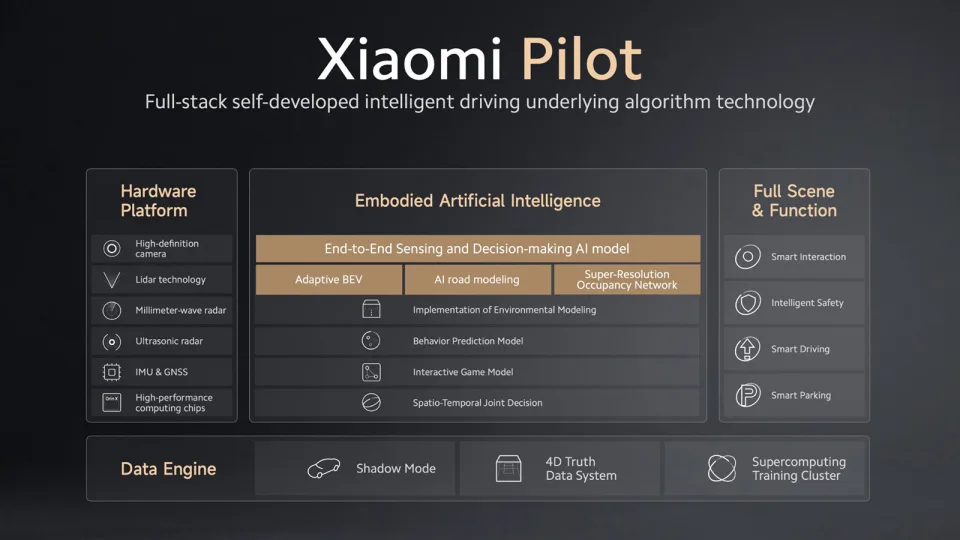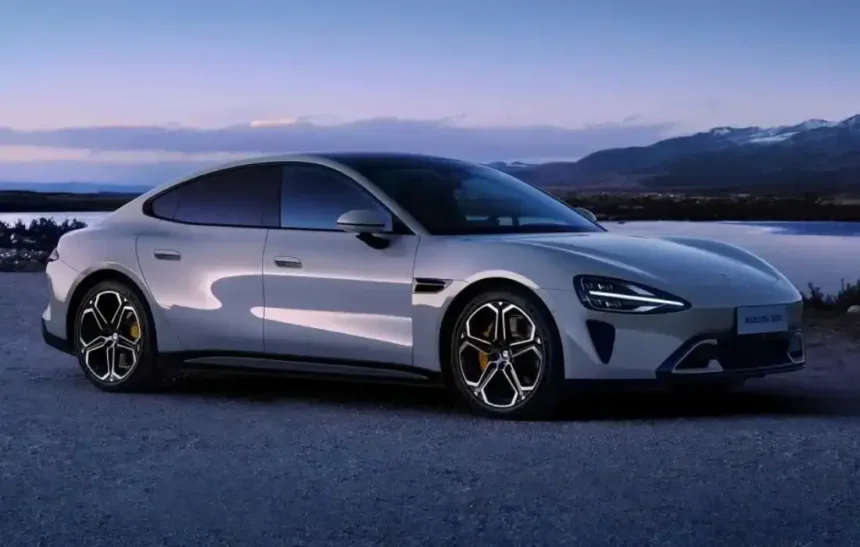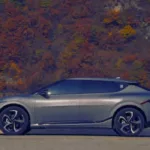Xiaomi, the renowned Chinese brand celebrated for its budget-friendly smartphones, is stepping into the electric car arena with its debutant, the Xiaomi SU7 EV. Unveiled at a recent event in Beijing, this sedan is built on Xiaomi’s Modena Architecture, boasting HyperEngine electric motors with an impressive 21,000rpm. Strikingly, the chassis is crafted by die-casting machines, exerting a formidable 9,100 tons of clamping force, outclassing Tesla’s equivalents.
The SU7 lineup introduces two variants: the SU7 Max, equipped with dual-motor all-wheel-drive, and the SU7, featuring a single-motor rear-wheel-drive configuration.
 Although the pricing details are yet to be disclosed, Xiaomi is already making bold claims about the SU7 Max’s capabilities. The electric sedan is purported to have an impressive range of up to 800km (497 miles) according to the China Light-Duty Vehicle Test Cycle (CLTC). Moreover, it boasts a rapid 0-100km/h acceleration of just 2.78 seconds, outperforming Tesla’s Model S and Porsche’s Taycan Turbo. This exceptional performance owes much to CATL’s cutting-edge 101kWh 800V high-voltage platform, facilitating a 220km range with a mere 5-minute charge, 390km in 10 minutes, or 510km in 15 minutes. The base model, powered by a 73.6kWh battery, supports 400V charging with a range of up to 668km or 415 miles.
Although the pricing details are yet to be disclosed, Xiaomi is already making bold claims about the SU7 Max’s capabilities. The electric sedan is purported to have an impressive range of up to 800km (497 miles) according to the China Light-Duty Vehicle Test Cycle (CLTC). Moreover, it boasts a rapid 0-100km/h acceleration of just 2.78 seconds, outperforming Tesla’s Model S and Porsche’s Taycan Turbo. This exceptional performance owes much to CATL’s cutting-edge 101kWh 800V high-voltage platform, facilitating a 220km range with a mere 5-minute charge, 390km in 10 minutes, or 510km in 15 minutes. The base model, powered by a 73.6kWh battery, supports 400V charging with a range of up to 668km or 415 miles.
Xiaomi’s foray into the automotive world was made possible by recruiting talent from the industry. CEO Lei Jun proudly revealed that Tianyuan Li, formerly associated with BMW’s iX series and iVision concepts, joined Xiaomi’s auto design team. Li was accompanied by James Qiu, a designer with experience at Mercedes-Benz’s Vision EQXX, and Chris Bangle, a veteran from BMW, serving as the design consultant.
 In terms of size, the SU7 aligns with the dimensions of the BMW 5 series, measuring 1,440mm tall, 1,963mm wide, and 4,997mm long. Colour options include the signature “aqua blue,” grey, or olive green. Lei emphasized the spacious legroom and trunk spaces, with 517L in the back and 105L in the front.
In terms of size, the SU7 aligns with the dimensions of the BMW 5 series, measuring 1,440mm tall, 1,963mm wide, and 4,997mm long. Colour options include the signature “aqua blue,” grey, or olive green. Lei emphasized the spacious legroom and trunk spaces, with 517L in the back and 105L in the front.
At the launch event, Lei highlighted distinctive features such as the “water droplet” headlamps resembling the Chinese character for “rice” (mi), and a halo rear brake light consisting of 360 LEDs. The SU7 also introduces the HyperOS in-car entertainment system, powered by Qualcomm’s Snapdragon 8295 processor, offering a swift 1.49-second boot time. The 16.1-inch 3K central screen supports multitasking, and optional Xiaomi Pad tablets can be mounted on magnetic ports behind the front headrests.
 Lei expressed Xiaomi’s commitment to opening up the Xiaomi CarIOT ecosystem to third parties, showcasing innovations like a smart booster car seat. Even iPhone users can enjoy Xiaomi car features, with support for wireless CarPlay and AirPlay connectivity, as well as iPad mounting for rear passengers.
Lei expressed Xiaomi’s commitment to opening up the Xiaomi CarIOT ecosystem to third parties, showcasing innovations like a smart booster car seat. Even iPhone users can enjoy Xiaomi car features, with support for wireless CarPlay and AirPlay connectivity, as well as iPad mounting for rear passengers.
Acknowledging the preference for physical buttons, Xiaomi retained some for climate control, along with extras for toggling the spoiler and adjusting body height. The SU7 promises autonomous driving capabilities with Xiaomi Pilot platform, powered by NVIDIA Drive Orin processors and an array of sensors, including Lidar.
 Lei outlined Xiaomi’s ambitious plan to conduct autonomous driving tests in 100 Chinese cities by the end of 2024. Additionally, he teased upcoming software updates and HyperEngine V8s, with a remarkable 27,200rpm, set to be integrated into cars by 2025. Xiaomi also hinted at next-gen electric motor tech based on carbon fibre, capable of an impressive 35,000rpm.
Lei outlined Xiaomi’s ambitious plan to conduct autonomous driving tests in 100 Chinese cities by the end of 2024. Additionally, he teased upcoming software updates and HyperEngine V8s, with a remarkable 27,200rpm, set to be integrated into cars by 2025. Xiaomi also hinted at next-gen electric motor tech based on carbon fibre, capable of an impressive 35,000rpm.
While the prices for the SU7 line remain undisclosed, Lei hinted at their expected high cost. As we await further details in the coming months, the global availability of the SU7 remains uncertain, with a U.S. launch seeming unlikely. Meanwhile, consumers can explore matching accessories like the Xiaomi 14, 14 Pro smartphones, and the Xiaomi Watch S3 eSIM in limited edition colours, aligning with the anticipated SU7 release.










